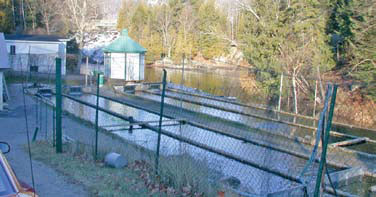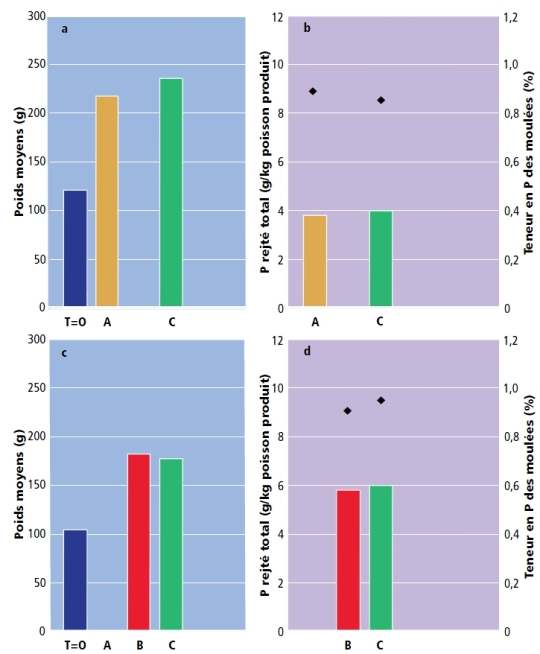Aquaculture Collaborative Research and Development Program (ACRDP) Fact Sheet
Issue 8 -
October 2010
Summary
Over the past two decades, improvements in the nutritional quality of the feeds used for salmonid production have made possible a very significant reduction in solid waste, phosphorus and nitrogen discharges and, ultimately, feed costs. At the same time, it has been suggested that the new, high-lipid feeds that have been developed could have negative impacts on the production of brook trout (Salvelinus fontinalis). The present study was carried out to verify the effect of lipid content in feed as well as the effect of certain lower-phosphorus replacement meals on the physiology of this species. The study's main conclusions show that: 1) the substitution of poultry by-product meal for fishmeal at a rate of 50% could yield a slight improvement in biological and environmental performance; 2) soy protein concentrate is not an advantageous protein source for replacing fishmeal; and 3) a feed low in lipids (18% based on feed formulation) seemed to yield slightly higher biological and environmental performance compared to a control feed that was higher in lipids (24% based on feed formulation). However, further basic biochemical and physiological research would be required to gain a good understanding of the specific qualities and different physiological stages of brook trout, with the ultimate goal of improving fish farm yields while reducing environmental impacts.
Introduction
In the late 1970s, trout feeds were relatively low in protein and lipids but high in starch. After it was realized that these feeds provided fish with a low nutrient supply, the proportions of starch were decreased significantly. The result was a feed with higher levels of digestible nutrients (protein and lipids). Improvements in feed quality have made possible a very significant reduction in solid waste, phosphorus and nitrogen discharges and, ultimately, feed costs.
Brook trout (Salvelinus fontinalis) is a salmonid species of major economic importance to Quebec's aquaculture industry. Despite recent improvements in feed formulations, brook trout producers question the capacity of this species to use lipids as an energy source. Some farmers believe that the new high-lipid feeds could have negative impacts on fish growth and lead to liver problems (liver enlargement due to lipid accumulation) and lethargy.
In accordance with current Quebec environmental legislation aimed at reducing nutrient discharges into receiving waters, feed manufacturers are now required to replace traditional fishmeal in the composition of their formulations with lower-phosphorus substitutes. However, few studies have considered the effect of those replacement meals on fish physiology and growth as well as on the feeding efficiency of the feeds.
Given the economic importance of brook trout and the current legislative context with respect to nutrient discharge reduction, the goal of the present study was to verify:
- whether the differences in lipid content between brook trout feeds have an impact on liver function and result in reduced growth performance; and
- whether the replacement meals used in the manufacture of low-phosphorus feeds affect the growth of this species.
Methods
All the feeds used (commercial and experimental) were manufactured by Skretting Canada. Table 1 presents the theoretical composition of the six tested feeds with respect to the percentage of replacement meal (poultry by-products or soy protein concentrate) and the protein, lipid and carbohydrate contents.
The research was conducted at two scales of analysis, namely a small-scale laboratory study at Université Laval's Laboratoire regional des sciences aquatiques (LARSA), and a larger-scale study in a commercial fish farming environment. The laboratory experiments were aimed at examining the effects of the different feeds on growth performance, liver function, body composition and phosphorus discharge. The promising experimental feeds then needed to be tested at commercial fish farms to validate the results obtained in the laboratory.
Table 1.
| Experimental feed | Theoretical composition (%) | ||
|---|---|---|---|
| Protein | Lipids | Carbohydrates | |
| A: Control (Orient LP) | 48 | 24 | 18 |
| B: Low-lipid | 48 | 18 | 25 |
| C: Subst. 50% poultry | 48 | 24 | 18 |
| D: Subst. 100% poultry | 48 | 24 | 18 |
| E: Subst. 35% soy protein concentrate | 48 | 24 | 18 |
| F: Subst. 70% soy protein concentrate | 48 | 24 | 18 |
At LARSA, the feeds were tested in triplicate, and the fish were kept in experimental tanks under constant conditions (Figure 1). At the fish farms, the fish were kept in commercial tanks under environmental conditions encountered in normal farming situations (Figure 2).
All feeds used in the trials were analyzed at LARSA to determine their actual composition. The fish samples collected at various times during the trials were also analyzed at LARSA. All analyses were conducted according to standard analytical methods. The main data collected included the mean weight of the sampled fish, their composition (to generate the phosphorus balance), and several biological performance parameters, namely feed conversion ratio (FCR), thermal growth coefficient(TGC), condition factor, visceral lipid deposition index and flesh colouration index. The enzymatic activity and glycogen content of the liver were also measured.

Figure 1
Experimental brook trout tanks at LARSA.

Figure 2
Commercial tank at Pisciculture Mont-Tremblant.
Results
In the Laboratory
Analysis of the final mean weights (Figure 3a) of the brook trout sampled at LARSA made it possible to identify the following trend with respect to the feeds: C > B > A > D > E > F. That trend shows the slight advantage of feeds C (50% poultry by-product meal) and B (low lipid content) over the control (feed A) and the other experimental feeds. Feeds E and F (soy protein concentrate substitutes) resulted in the poorest performance.
The use of the experimental feeds did not generate any significant difference in the activity of alanine aminotransferase (ALT) or aspartate aminotransferase (AST), the most important liver enzymes in fish. With respect to liver glycogen, the differences between the treatments were not statistically significant.
The phosphorus balances in this experiment were very interesting from an environmental perspective with respect to phosphorus discharge reduction. As shown in Figure 3b, feeds C, D and E yielded total P discharge values between 4.5 and 4.7 g P/kg fish produced. Figure 3b also shows the relationship between feed P content and total P discharge. Feeds A and B, which both had P contents close to 1.05%, generated the highest discharges. Given that the FCRs were very similar, the difference among the discharges may be necessarily attributable to the difference between the P contents in the feeds.
![LARSA – a. Final mean weight of the brook trout after 112 days, and b. phosphorus discharge (bars) and content (•) according to the different experimental feeds (A to F) [The vertical error bars represent the standard error of the mean. Means that do not share the same letter are significantly different (P<0.05)].](/aquaculture/images/acrdp-pcrda/fsheet-ftechnique/08/08-03-eng.jpg)
Figure 3
LARSA – (a) Final mean weight of the brook trout after 112 days, and (b) phosphorus discharge (bars) and content (♦) according to the different experimental feeds (A to F) [The vertical error bars represent the standard error of the mean. Means that do not share the same letter are significantly different (P<0.05)].
On Commercial Farms
On the basis of the results obtained in the laboratory, it was decided to conduct trials at commercial fish farms with the feeds that showed the greatest potential, namely feeds B (low lipid content) and C (50% poultry by-product meal). The commercial farm results are from Pisciculture Mont-Tremblant. In the spring, the control (feed A) was tested against feed C, and in the fall, feed B was compared to feed C (which had become the new control formulation owing to a modification by Skretting Canada).
Differences were found in the P content of diets A, B, and C, between the lab and field studies. The explanation for these differences is that, for the lab experiment, Skretting Canada had specially manufactured diets B through F; diet A (control) was their commercial Orient LP at the onset of the experiment. Diets A, B, and C that were used for the field experiment came from a different manufacturing lot, which had slightly different compositions (the one exception was diet C in the spring experiment). This explains the difference in P content between the "same diets". The two trials at Pisciculture Mont-Tremblant (Figures 4a and 4c) revealed trends similar to those obtained in the laboratory. Feed C performed better than the control (feed A), although feed B was more advantageous than feed C in the second trial.
With respect to total P discharge, none of the treatments seemed to show any notable difference (Figures 4b and 4d). However, the total P discharge values for the spring trial (Figure 4b) were below 4.0 g P/kg fish produced for the period under study. Such low total P discharge values (in the laboratory and on the farm) are very interesting, because the targets set for the Stratégie de développement durable de l'aquaculture en eau douce au Québec (STRADDAQ) are 4.2 g P discharge in effluent per kilogram of fish.

Figure 4
Pisciculture Mont-Tremblant – Final mean weight of brook trout after 57 (a) and 70 (c) days, and respective phosphorus discharges (bars) and contents (♦) (b and d) according to experimental feeds A, B and C.
Conclusions
Based on the studies conducted in the laboratory and on commercial farms, it was possible to demonstrate that:
- the differences in lipid content between the brook trout feeds did not cause any significant changes in liver function or growth performance; and
- the lower-phosphorus replacement meals used to manufacture the experimental feeds did not necessarily lead to reduced growth performance.
The feeds containing soy protein concentrate exhibited some reduction in growth performance and also seemed to generate certain problems related to tank cleanliness.
The formulations of feed B (lower lipid content) and feed C (50% replacement with poultry by-products) produced superior results, for more than one parameter, than the formulation of the control feed (feed A).
However, this study demonstrates the need for further basic biochemical and physiological research to gain a good understanding of the specific qualities and different physiological stages of brook trout, with the ultimate goal of reducing the possible environmental impacts of fish farms while at the same time ensuring that farms can increase their yields.
This ACRDP project (Q-05-01-005) was a collaborative effort between the Department of Fisheries and Oceans (DFO Science) and the Société de recherche et développement en aquaculture continentale inc. (SORDAC). One of the scientists on this project, Eric Boucher, can be contacted at eric.boucher@ipsfad.ca.
For further information on this and other ACRDP projects, visit: /aquaculture/acrdp-pcrda/index-eng.htm,
and https://www.mapaq.gouv.qc.ca/fr/Pages/Accueil.aspx (in French only).
Published by:
Aquaculture Science Branch
Fisheries and Oceans Canada
Ottawa, Ontario K1A 0E6
©Her Majesty the Queen in Right of Canada 2010
ISSN 1919-6849 (Print)
ISSN 1919-6857 (Online)
DFO/2008-1493
French version and alternative formats available through: /aquaculture/acrdp-pcrda/index-fra.htm
- Date modified: